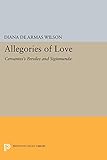Allegories of Love : Cervantes's Persiles and Sigismunda / Diana de Armas Wilson.
Material type: TextSeries: Princeton Legacy Library ; 1165Publisher: Princeton, NJ : Princeton University Press, [2014]Copyright date: ©1991Edition: Course BookDescription: 1 online resource (282 p.)Content type:
TextSeries: Princeton Legacy Library ; 1165Publisher: Princeton, NJ : Princeton University Press, [2014]Copyright date: ©1991Edition: Course BookDescription: 1 online resource (282 p.)Content type: - 9780691607238
- 9781400861798
- 863/.309 23
- PQ6327.P5
- online - DeGruyter
- Issued also in print.
| Item type | Current library | Call number | URL | Status | Notes | Barcode | |
|---|---|---|---|---|---|---|---|
 eBook
eBook
|
Biblioteca "Angelicum" Pont. Univ. S.Tommaso d'Aquino Nuvola online | online - DeGruyter (Browse shelf(Opens below)) | Online access | Not for loan (Accesso limitato) | Accesso per gli utenti autorizzati / Access for authorized users | (dgr)9781400861798 |
Browsing Biblioteca "Angelicum" Pont. Univ. S.Tommaso d'Aquino shelves, Shelving location: Nuvola online Close shelf browser (Hides shelf browser)

|

|

|

|

|

|

|
||
| online - DeGruyter The End Crowns All : Closure and Contradiction in Shakespeare's History / | online - DeGruyter Post-Petrarchism : Origins and Innovations of the Western Lyric Sequence / | online - DeGruyter Words of Eternity : Blake and the Poetics of the Sublime / | online - DeGruyter Allegories of Love : Cervantes's Persiles and Sigismunda / | online - DeGruyter Proclaiming a Classic : The Canonization of Orlando Furioso / | online - DeGruyter Noh Drama and The Tale of the Genji : The Art of Allusion in Fifteen Classical Plays / | online - DeGruyter A History of Japanese Literature, Volume 3 : The High Middle Ages / |
Frontmatter -- CONTENTS -- ACKNOWLEDGMENTS -- INTRODUCTION -- PART ONE. Context and Subtexts -- Chapter One. KIDNAPPING ROMANCE -- Chapter Two. CANONIZING ROMANCE -- Chapter Three. SOME VERSIONS OF ALLEGORY -- Chapter Four. CERVANTES AND THE ANDROGYNE -- PART TWO. The Text -- Chapter Five. CERVANTES ON CANNIBALS -- Chapter Six. PLOT AND AGENCY -- Chapter Seven. THIRTEEN EXEMPLARY NOVELS -- PART THREE. The Woman in the Text -- Chapter Eight. A ROMANCE OF RAPE: TRANSILA FITZMAURICE -- Chapter Nine. SOME PERVERSIONS OF PASTORAL: FELICIANA DE LA VOZ -- Chapter Ten. THE HISTRIONICS OF EXORCISM: ISABELA CASTRUCHA -- EPILOGUE -- INDEX
restricted access online access with authorization star
http://purl.org/coar/access_right/c_16ec
In the work he considered his masterpiece, Persiles and Sigismunda, Cervantes finally explores the reality of woman--an abstraction largely idealized in his earlier writing. Traditional critics have perpetuated this disembodied ideal woman: "Every Man," claimed the translators of the 1706 Don Quixote, has "some darling Dulcinea of his Thoughts." As Diana de Armas Wilson shows, however, Cervantes himself envisioned the radical embodiment of "Dulcinea" in the later Persiles, a pan-European Renaissance allegory. Wilson illuminates Cervantes's strategic use of the ancient genre of Greek romance to contest various chivalric fictions about women, love, and marriage--fictions collapsing under the constraints of an emerging bourgeois culture. Taking as her subject Cervantes's erotic imperative--to leave behind "barbaric" notions of love in quest of a new conceptual space--Wilson demonstrates how the heroes of the Persiles, unlike Don Quixote, learn to cross the borders of difference. Their journey toward marriage is illustrated by thirteen inset "exemplary novels," perhaps the most exploratory of Cervantes's writings. Allegories of Love not only examines the fundamental importance of sexual and cultural difference in Cervantes's last romance, but also reveals the historical conditions of representation itself during the late Renaissance.Originally published in 1991.The Princeton Legacy Library uses the latest print-on-demand technology to again make available previously out-of-print books from the distinguished backlist of Princeton University Press. These editions preserve the original texts of these important books while presenting them in durable paperback and hardcover editions. The goal of the Princeton Legacy Library is to vastly increase access to the rich scholarly heritage found in the thousands of books published by Princeton University Press since its founding in 1905.
Issued also in print.
Mode of access: Internet via World Wide Web.
In English.
Description based on online resource; title from PDF title page (publisher's Web site, viewed 30. Aug 2021)


